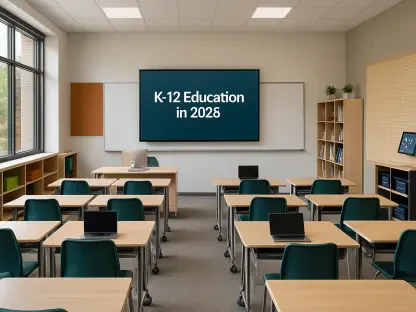The global education landscape is in the midst of an unprecedented transformation. Virtual classrooms have emerged as a crucial element in this transformation, offering a digital learning environment that facilitates interaction, collaboration, and instruction beyond the limitations of physical classrooms. As we approach 2030, many wonder just how much virtual classrooms will reshape global education.
The Rise of Virtual Classrooms
Technological Advancements Fueling Growth
The surge in technological advancements has been instrumental in the adoption and evolution of virtual classrooms. Innovations such as real-time collaboration tools, interactive whiteboards, breakout rooms, and gamification elements are revolutionizing the way teaching and learning occur online. These features enhance user engagement, making virtual classrooms increasingly comparable to traditional ones.
Advances in internet speeds and the proliferation of mobile devices also contribute to the growth of virtual classrooms. High-speed connectivity and accessibility have made it possible for students and educators to participate in virtual learning from virtually anywhere in the world, breaking geographic barriers and democratizing access to education. This technological leap has not only made education more inclusive but has also enabled continuous learning in unprecedented times, like during the COVID-19 pandemic.
Market Growth and Projections
The virtual classroom market is experiencing rapid growth, driven by the widespread adoption among educational institutions, corporations, and training centers. Valued at USD 6 billion in 2023, the market is projected to reach USD 15 billion by 2030, reflecting a compound annual growth rate (CAGR) of 18.4%. This growth is indicative of the increasing reliance on digital education solutions to meet the demands of modern learners.
The COVID-19 pandemic acted as a catalyst, accelerating the shift towards virtual classrooms. With lockdowns and social distancing measures in place, educational institutions had no choice but to adopt online learning platforms. This temporary solution has since evolved into a long-term strategy, with many institutions recognizing the benefits of virtual classrooms for flexible, effective learning. The pandemic essentially acted as a proving ground, showcasing the efficiency and adaptability of virtual education.
Benefits of Virtual Classrooms
Global Reach and Accessibility
One of the most significant advantages of virtual classrooms is their ability to reach a global audience. Students from various parts of the world can access the same educational content, participate in discussions, and collaborate on projects regardless of their geographic location. This global reach facilitates cultural exchange and promotes a more diverse learning environment, which is invaluable in today’s interconnected world.
Flexibility is another key benefit. Virtual classrooms offer the convenience of accessing courses at any time, catering to different time zones and individual schedules. This flexibility is particularly beneficial for working professionals and lifelong learners who need to balance education with other commitments. The ability to learn at one’s own pace without the constraints of a rigid schedule makes education more accessible and tailored to individual needs.
Cost-Effectiveness and Resource Efficiency
Virtual classrooms also offer cost-effective solutions for both institutions and students. Traditional education requires significant investments in physical infrastructure, such as buildings, classrooms, and facilities. Virtual classrooms, on the other hand, eliminate these costs, allowing institutions to allocate resources more efficiently, thereby reducing overhead and operational expenses.
For students, virtual classrooms reduce expenses related to commuting, accommodation, and study materials. Digital resources can be easily shared and accessed, providing a more sustainable and environmentally friendly approach to education. The reduction in the use of physical textbooks and other materials also supports ecological sustainability, aligning with global efforts to reduce carbon footprints and promote green learning environments.
The Competitive Landscape
Key Market Players
The virtual classroom market is characterized by significant competition among key players, each contributing to its development through innovation and strategic initiatives. Companies such as Sony Corporation, Samsung Electronics, HTC Corporation, Google LLC, Microsoft Corporation, and Panasonic Corporation are at the forefront, leveraging their technological expertise to enhance virtual learning experiences. These giants are continuously pushing the envelope, introducing more advanced and user-friendly features to stay ahead in the market.
Other notable players include Hitachi, Barco NV, LG Electronics, Veative Labs, Cisco Systems, Blackboard Inc., Dell Technologies, IBM Corporation, Saba Software Inc., Oracle Corporation, Edvance360, Electa Communications, and BrainCert. These companies offer a range of solutions, from software platforms to hardware devices, catering to diverse educational needs. By providing comprehensive ecosystems that support various learning styles and requirements, these players ensure a well-rounded and enriched educational experience.
Noteworthy Collaborations and Acquisitions
Strategic collaborations and acquisitions are shaping the competitive landscape, as companies seek to strengthen their positions and broaden their offerings. A prime example is Class’s acquisition of Anthology’s Blackboard Collaborate. This partnership aims to integrate Blackboard Collaborate’s virtual classroom services with Class’s Zoom-based platform, offering an enhanced digital learning experience for over 1,750 educational institutions.
Such collaborations highlight the ongoing efforts to pool technical expertise and resources, driving innovation and improving the overall quality of virtual classrooms. These strategic moves are essential for staying competitive in a rapidly evolving market. By combining strengths and mitigating weaknesses, companies can deliver more robust and versatile virtual education solutions that cater to a wider audience and diverse learning needs.
Regional Insights
North America and Europe’s Dominance
North America and Europe currently dominate the virtual classroom market, thanks to their advanced digital infrastructure and proactive educational policies. In these regions, high internet penetration and widespread availability of digital devices have created a conducive environment for the adoption of virtual learning solutions. Additionally, the robust technological ecosystem in these areas supports continuous innovation and integration of emerging technologies into educational frameworks.
Government initiatives and funding have also played a significant role in promoting digital education. Policies supporting online learning and professional development for educators have accelerated the integration of virtual classrooms into mainstream education systems. These strategic efforts ensure that both educators and learners are equipped with the necessary skills and tools for effective digital learning, fostering an environment of continuous improvement and adaptation.
Asia-Pacific’s Rapid Growth
The global education system is undergoing a remarkable transformation, with virtual classrooms leading the charge. These digital learning spaces have become essential, enabling interaction, collaboration, and instruction beyond the confines of traditional physical classrooms. As a result, educators and students can connect and engage in ways that were previously unimaginable, regardless of geographic limitations. Virtual classrooms leverage cutting-edge technology to provide real-time feedback, a plethora of resources, and individualized learning experiences tailored to each student’s needs. This shift is democratizing education, making quality learning accessible to more people across various socio-economic backgrounds. Looking ahead to 2030, the potential impact of virtual classrooms on global education is immense. They promise to make education more inclusive, flexible, and relevant to the modern world. By breaking down barriers and promoting lifelong learning, virtual classrooms could very well become the cornerstone of educational systems worldwide, fundamentally reshaping how we view and achieve educational success.









